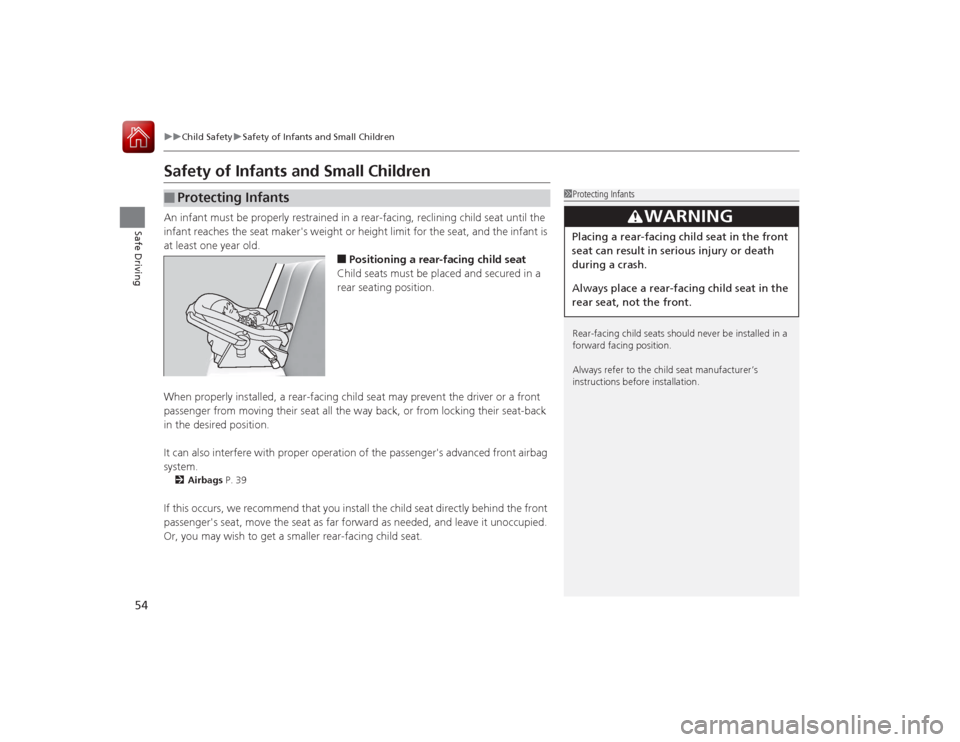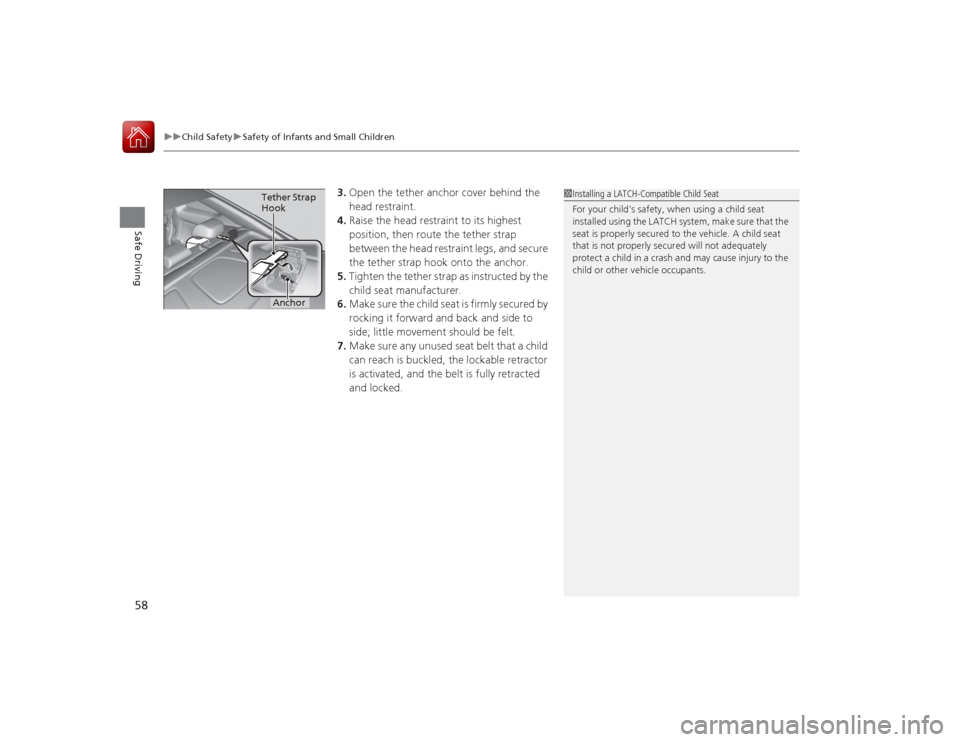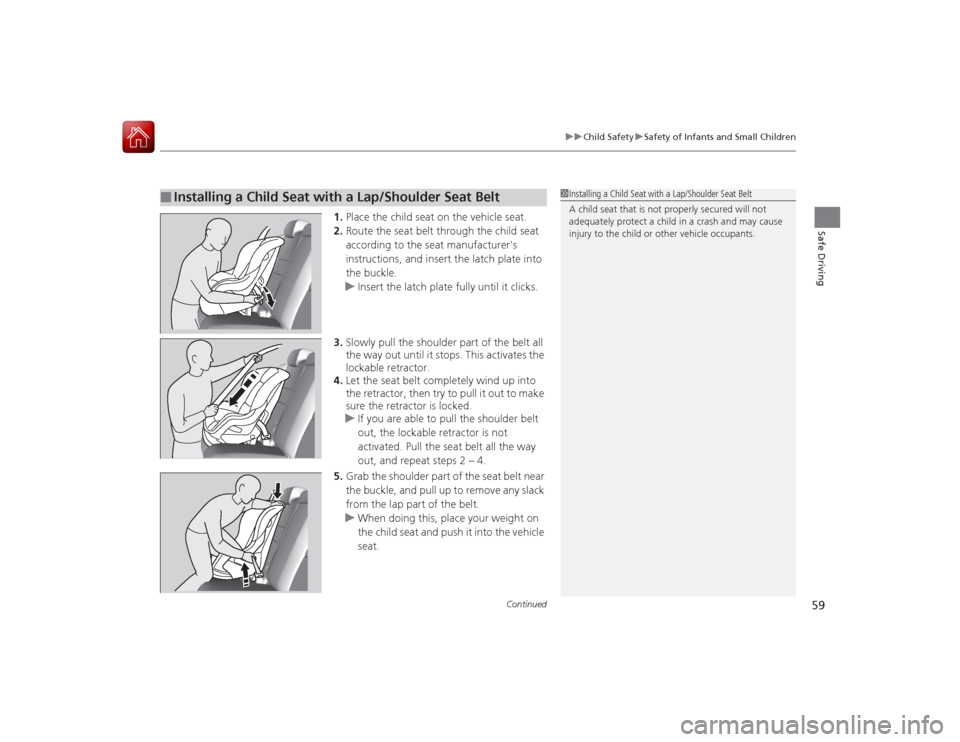Page 54 of 557

53
uuChild Safety uProtecting Child Passengers
Safe Driving
• Any child who is too small to wear a seat belt correctly must be restrained in an
approved child seat that is properly secured to the vehicle using either the lap belt
portion of the lap/shoulder belt or the lower anchors of the LATCH system.
• Never hold a child on your lap because it is impossible to protect them in the
event of a collision.
• Never put a seat belt over yourself and a child. During a crash, the belt would
likely press deep into the child and cause serious or fatal injuries.
• Never let two children use the same seat belt. Both children could be very
seriously injured in a crash.
• Do not allow children to operate the doors, windows or seat adjustments.
• Do not leave children in the vehic le unattended, especially in hot weather when
the inside of the vehicle can get hot enou gh to kill them. They could also activate
vehicle controls causing it to move unexpectedly.
1 Protecting Child Passengers
To deactivate a lockable retractor, release the buckle
and allow the seat belt to wind up all the way.
To remind you of the passenger's front airbag
hazards and child safety, your vehicle has warning
labels on the dashboard (U.S. models) and on the
front visors. Please read and follow the instructions
on these labels.
2 Safety Labels P. 65
3
WARNING
Allowing a child to play with a seat belt or
wrap one around their neck can result in
serious injury or death.
Instruct children not to play with any seat
belt and make sure any unused seat belt a
child can reach is bu ckled, fully retracted,
and locked.
Page 55 of 557

54
uuChild Safety uSafety of Infants and Small Children
Safe Driving
Safety of Infants and Small ChildrenAn infant must be properly restrained in a rear-facing, reclining child seat until the
infant reaches the seat maker's weight or height limit for the seat, and the infant is
at least one year old.
■Positioning a rear-facing child seat
Child seats must be placed and secured in a
rear seating position.
When properly installed, a rear-facing child seat may prevent the driver or a front
passenger from moving their seat all the way back, or from locking their seat-back
in the desired position.
It can also interfere with proper operation of the passenger's advanced front airbag
system.
2 Airbags P. 39If this occurs, we recommend that you install the child seat directly behind the front
passenger's seat, move the seat as far forward as needed, and leave it unoccupied.
Or, you may wish to get a smaller rear-facing child seat.■
Protecting Infants
1Protecting Infants
Rear-facing child seats should never be installed in a
forward facing position.
Always refer to the chi ld seat manufacturer’s
instructions before installation.
3
WARNING
Placing a rear-facing child seat in the front
seat can result in serious injury or death
during a crash.
Always place a rear-facing child seat in the
rear seat, not the front.
Page 59 of 557

uuChild Safety uSafety of Infants and Small Children
58Safe Driving
3. Open the tether anchor cover behind the
head restraint.
4. Raise the head restraint to its highest
position, then route the tether strap
between the head restraint legs, and secure
the tether strap hook onto the anchor.
5. Tighten the tether strap as instructed by the
child seat manufacturer.
6. Make sure the child seat is firmly secured by
rocking it forward and back and side to
side; little movement should be felt.
7. Make sure any unused seat belt that a child
can reach is buckled, the lockable retractor
is activated, and the belt is fully retracted
and locked.
1Installing a LATCH-Compatible Child Seat
For your child's safety, when using a child seat
installed using the LATCH system, make sure that the
seat is properly secured to the vehicle. A child seat
that is not properly secured will not adequately
protect a child in a crash and may cause injury to the
child or other vehicle occupants.
Anchor
Tether Strap
Hook
Page 60 of 557

Continued
59
uuChild Safety uSafety of Infants and Small Children
Safe Driving
1. Place the child seat on the vehicle seat.
2. Route the seat belt through the child seat
according to the seat manufacturer's
instructions, and insert the latch plate into
the buckle.
u Insert the latch plate fully until it clicks.
3. Slowly pull the shoulder part of the belt all
the way out until it stops. This activates the
lockable retractor.
4. Let the seat belt completely wind up into
the retractor, then try to pull it out to make
sure the retractor is locked.
u If you are able to pull the shoulder belt
out, the lockable retractor is not
activated. Pull the seat belt all the way
out, and repeat steps 2 – 4.
5. Grab the shoulder part of the seat belt near
the buckle, and pull up to remove any slack
from the lap part of the belt.
u When doing this, place your weight on
the child seat and push it into the vehicle
seat.
■
Installing a Child Seat with a Lap/Shoulder Seat Belt
1Installing a Child Seat with a Lap/Shoulder Seat Belt
A child seat that is not properly secured will not
adequately protect a child in a crash and may cause
injury to the child or other vehicle occupants.
Page 61 of 557
uuChild Safety uSafety of Infants and Small Children
60Safe Driving
6. Make sure the child seat is firmly secured by
rocking it forward and back and side to
side; little movement should be felt.
7. Make sure any unused seat belt that a child
can reach is buckled, the lockable retractor
is activated, and the belt is fully retracted
and locked.
1Installing a Child Seat with a Lap/Shoulder Seat Belt
To deactivate a lockable retractor, release the buckle
and allow the seat belt to wind up all the way.
Page 72 of 557

71
uuIndicators u
Continued
Instrument Panel
*1:Models with the smart entry system have an ENGINE START/STOP button instead of an ignition switch.Indicator
Name
On/Blinking
Explanation
Transmission
Indicator
*
●Blinks if the transmission system has a problem.
●Blinks while driving - Avoid sudden starts
and acceleration and have your vehicle checked
by a dealer immediately.
Seat Belt
Reminder
Indicator
●Comes on and the beeper sounds if you are not
wearing a seat belt when you turn the ignition
switch to ON
(w
*1.
●If the front passenger is not wearing a seat belt,
the indicator comes on a few seconds later.●Blinks while driving if either you or the front
passenger has not fastened a seat belt. The
beeper sounds and the indicator blinks at regular
intervals.
●The beeper stops and the indicator goes off
when you and the front passenger fasten their
seat belts.●Stays on after you or the front passenger
has fastened the seat belt - A detection
error may have occurred in the sensor. Have
your vehicle checked by a dealer.
2 Seat Belt Reminder P. 33
Low Fuel
Indicator
●Comes on when the fuel reserve is running low
(approximately 2.6 U.S. gal./9.7 Liter left).●Blinks if there is a problem with the fuel gauge.
●Comes on - Refuel your vehicle as soon as
possible.●Blinks - Have your vehicle checked by a dealer.
Anti-lock Brake
System ( ABS)
Indicator
●Comes on for a few seconds when you turn the
ignition switch to ON
(w
*1, then goes off.
●If it comes on at any other time, there is a problem
with the ABS.
●Stays on constantly - Have your vehicle
checked by a dealer. With this indicator on,
your vehicle still has normal braking ability but
no anti-lock function.
2 Anti-lock Brake System (ABS) P. 442
* Not available on all models
Page 75 of 557

74
uuIndicators u
Instrument Panel
*1:Models with the smart entry system have an ENGINE START/STOP button instead of an ignition switch.Indicator
Name
On/Blinking
Explanation
High Beam
Indicator
●Comes on when the high beam headlights are on.
—
Lights On
Indicator
●Comes on whenever the light switch is on, or in
AUTO when the exterior lights are on.
●If you remove the key from the ignition switch
*1
while the exterior lights are on, a chime sounds
when the driver's door is opened.
Fog Light
Indicator
*
●Comes on when the fog lights are on.
—
Immobilizer
System Indicator
●Comes on briefly when you turn the ignition
switch to ON
(w
*1, then goes off.
●Comes on if the immobilizer system cannot
recognize the key information.
●Blinks - You cannot start the engine. Turn the
ignition switch to LOCK
(0
*1, pull the key out,
and then insert the key and turn it to ON
(w
*1
again.
●Repeatedly blinks - The system may be
malfunctioning. Have your vehicle checked by a
dealer.●Do not attempt to alter this system or add
other devices to it. Electrical problems can
occur.
Security System
Alarm Indicator
●Blinks when the security system alarm has been
set.
2 Security System Alarm P. 103
Indicator
* Not available on all models
Page 76 of 557

75
uuIndicators u
Continued
Instrument Panel
*1:Models with the smart entry system have an ENGINE START/STOP button instead of an ignition switch.Indicator
Name
On/Blinking
Explanation
Message
Forward
Collision
Warning
(FCW )
Indicator
*●Comes on for a few seconds
when you turn the ignition
switch to ON
(w
*1, then goes
off.
●Comes on when you have
customized FCW to turn off.●Comes on if there is a problem
with the FCW system.
●Stays on constantly without FCW off - Have your
vehicle checked by a dealer.
●Blinks when the system detects
a likely collision with a vehicle
in front of you. The beeper
sounds.
●Blinks while driving - Take appropriate action to prevent
a collision (apply the brakes, change lanes, etc.).
—
●Comes on when the FCW
system shuts itself off.
●Stays on - The temperature inside the FCW system is too high.
The system activates when the tem perature inside the system
cools down.
2 Automatic shutoff P. 426
●Stays on - The area around the camera is blocked by dirt, mud,
etc. Stop your vehicle in a safe place, and wipe it off with a soft
cloth.●Have your vehicle checked by a dealer if the indicator and
message come back on after you cleaned the area around
the camera.
2 Automatic shutoff P. 4262Automatic shutoff P. 426
—
* Not available on all models